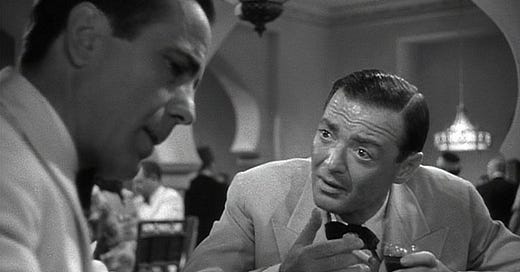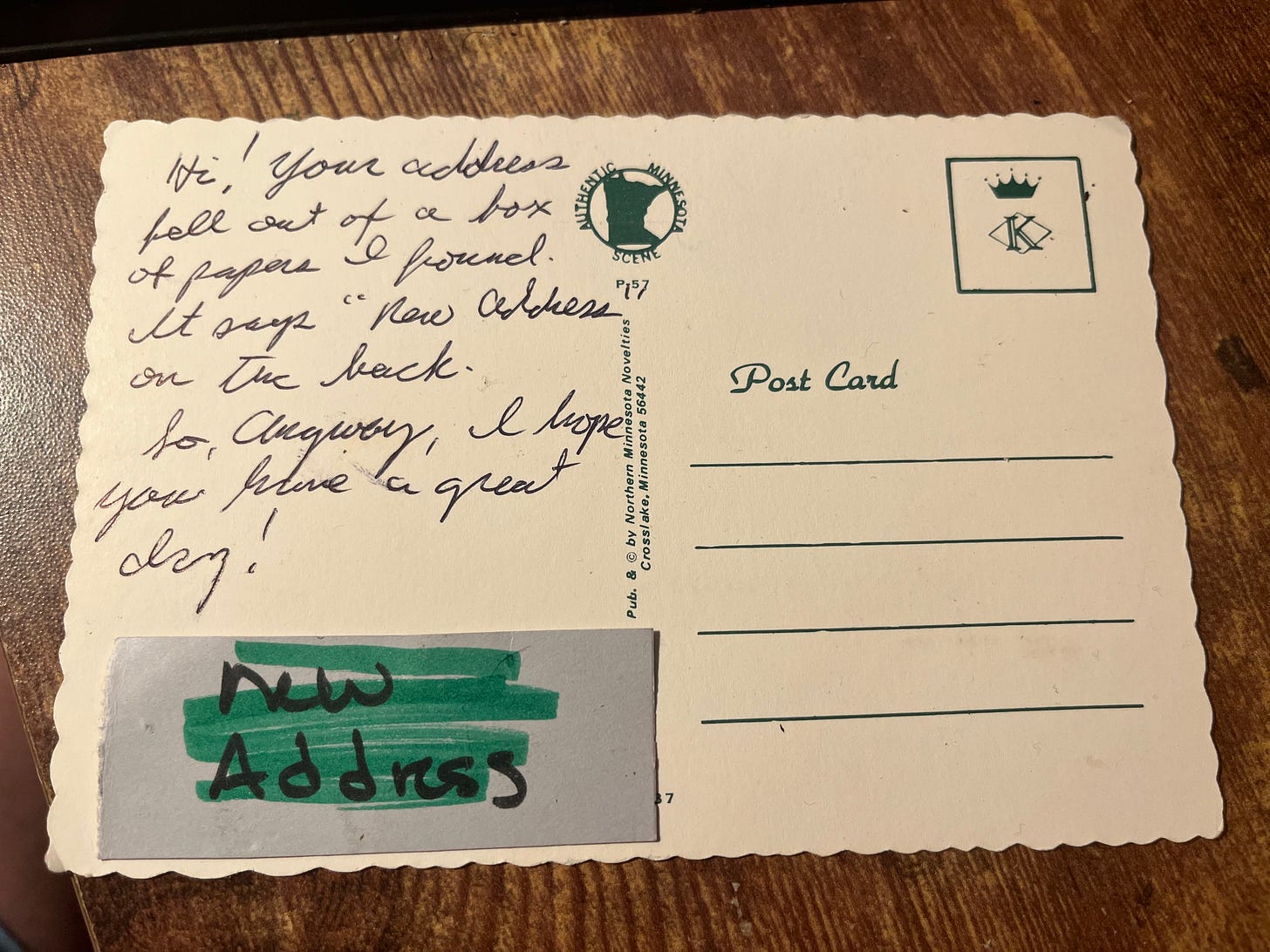Like many kooky practices, postcard Twitter stemmed from a moment of possession. Too much time, too little sleep, and more postcards than I practically knew what to do with. I picked up a fistful of second-hand postcards at a junk shop in Moscow, Idaho, and by the time we made Elgin, Illinois, they were burning a hole in my pocket, and I had no one left to send them to.
As we headed out of Elgin, I noted an address and dashed off: “Wish we could have stayed longer, but we had a blast in your town.” I posted it a few hours later on the road.
A second of unexpected relief from mailbox monotony is a little gift everyone needs, or at least that’s what I hope. By the time we made it back to the East Coast, practice turned to hobby turned to pleasant compulsion.
I bought 200 postcards bulk on eBay followed in quick succession by a neato postage stamp holder for my desk. As I’ve mentioned elsewhere, I started returning the “used” postcards to their rightful addresses and used the blanks as an analog Twitter.
If there’s something goofy bouncing around in my head, instead of Tweeting it, I write it on a blank postcard and mail it to a random address.
A Postcard Looking for an Address
Choosing random addresses was important because I didn’t want anyone to feel stalked or put-upon. Honestly, most of the addresses I’ve chosen are pulled from old newspapers (although I have typed potential addresses, like 428 E. 26th Street, into Google Maps to see if it’s a house somewhere).
Sometimes I’ll send them to addresses written on the inside covers of used books (and recently to an address I found on a slip of paper), but newspapers are my go-to.
A weird fact of journalism history is newspapers used to put people’s addresses in stories. Mary Davis of 123 so-and-so Street testified in court, that sort of thing. They were notoriously used in obituaries, to the point where there was a piece of street wisdom claiming the obits section was the best place to find apartments and used cars (old people take better care of their cars).
In “When Harry Met Sally,” Harry opines that the real estate and obituary section should be combined.
The randomness of my little project is way more enjoyable than the anonymity. It wouldn’t be any fun if I thought I was ruining someone’s day, rather than offering a little respite from it. To that end, I’ve started stamping them with my web address as a signature. It’s my way of assuring people there’s no mysterious or malicious person watching them. They can check here and see I’m just a kook. I still send them unsigned to my friends, though.
Recently I had occasion to send my first one to a “famous” person, the actor Peter Lorre, best known as Ugarte in Casablanca, though he played a billion great, creepy, creepy roles. So much so that he eventually became a caricature, literally, in Bugs Bunny cartoons. Think of him as a (probably) nice guy who played “creepy” too well for too long, like Jake Gyllenhaal, maybe. I came across Lorre’s address in a newspaper account that I thought was just fabulous. It’s the report of his death in 1964, which is where he enters my story.
I have to be honest when I tell you that I have zero idea which rabbit I was chasing down what hole when I came across his death notice, but whatever it was was less intriguing.
Peter Lorre died of a stroke on the eve of his third divorce. He was staying in an apartment on Hollywood Blvd. and his maid found him unresponsive. His would-be ex-wife arrived at court to find she was his widow. There’s an emotion we probably don’t have a name for, Schadenfreude for grief.
They’d been married 10 years and had a daughter.
WAIT!!!
According to Wikipedia, the daughter was targeted by the Hillside Strangler in the early 70s but he let her go when he heard she was Peter Lorre’s kid. How bananas is that?!
The paper listed the address of the Hollywood apartment he occupied during the estrangement as well as his wife’s Beverly Hills home address. I thought that was great and dashed off a postcard that said, ‘Do you know you live in Peter Lorre’s ex-wife’s house?’ or something like that.
Before I start the next part, it’s important to let you know I’ve only known about the serial killer thing for about 20 minutes as of this writing. I came across it as part of a final edit fact-check. Also, Catharine Lorre died of natural causes in the 1980s.
Whenever I find a random address, it just makes sense to check Google Streetview to make sure I’m not mailing something to an empty lot.
Streetview is one of my favorite parts of the internet. I’ve been able to “walk” neighborhoods that I’m writing about even if they’re across the country. I’ve looked back through the years at my own house and found an image of a long-gone family cat.
My favorite is of me working on the porch. I was still smoking cigarettes at the time so the front porch was essentially my office. When the Google car passed, I leaped up and ran to take a photo, as much for proof as anything. Still, at the right angle during the right year, you can see me immortalized as a spec in the distance holding up a phone.
It never occurred to me that people wouldn’t want their house on Streetview, let alone have the motivation and wherewithal to have it erased. Still, whoever occupies the former Lorre residence might be over having a famous-ish address. This is what his house looks like on Streetview today:
My brief moral quandary was whether to send the postcard anyway, given that these seem like private people, but when your zip code is 90210 it’s hard to take your privacy concerns seriously.
Without judgment, I feel like if you buy a celebrity house, it’s like buying a home in a flight path - disturbances are part of the deal, only more so in a town that has traded on its wealth, fame, and infamy for going on a century now.
Still, I identified myself, so I figure they can call and yell at me (all my information is REALLY easy to find online), or yell at the LA Times and newspapers generally for the 1960s doxxing.
Anyway, whatever happens, I have another story, which is the real point of this Return to Sender thing.
By the way, if you want me to add you to my postcard mailing list, shoot me a note and I’ll send you something random and unsigned.
Epilogue
I searched the address and it only appeared in one other instance I could find. A year before he died, Peter Lorre sued a real estate salesman who wanted to change his name to Peter Lorie because his given name was “too hard to pronounce.” He also looked like Peter Lorre, a bit.
The judge threw out the case and denied the name change, which seems quaint in a world where people regularly have plastic surgery to make their faces look more like famous people’s.
Undeterred, Eugene Weingand took the stage name Peter Lorre Jr., following the actor’s death. Trading on the possibility that he was Lorre’s son, he got a couple of acting gigs. I sent a note to that address as well.







